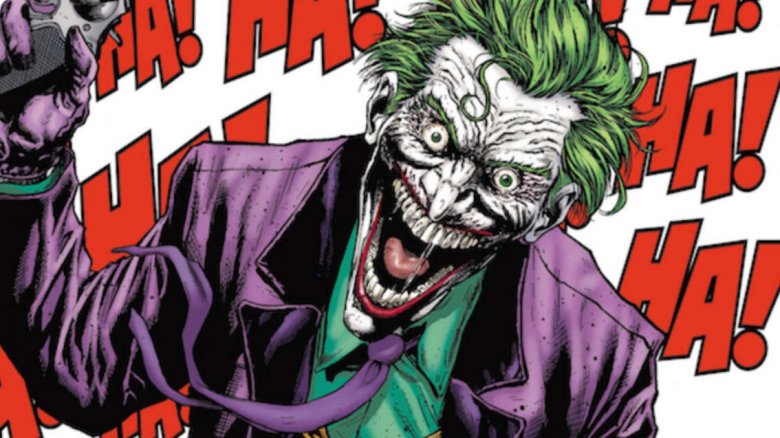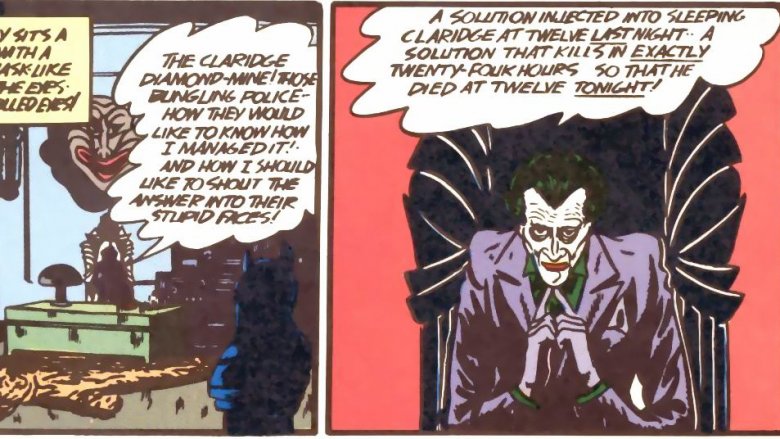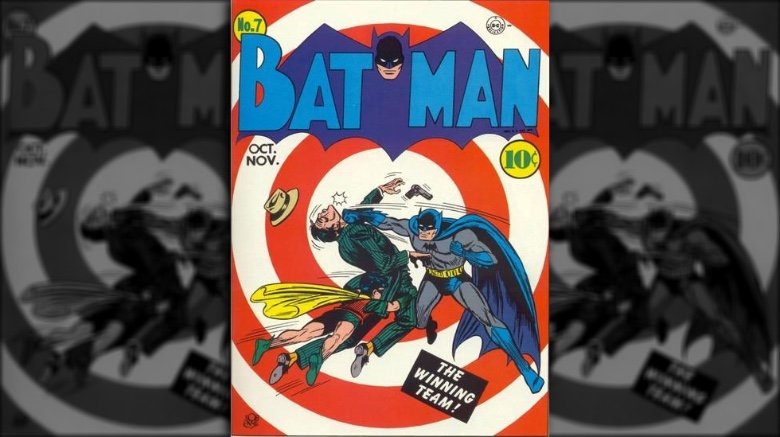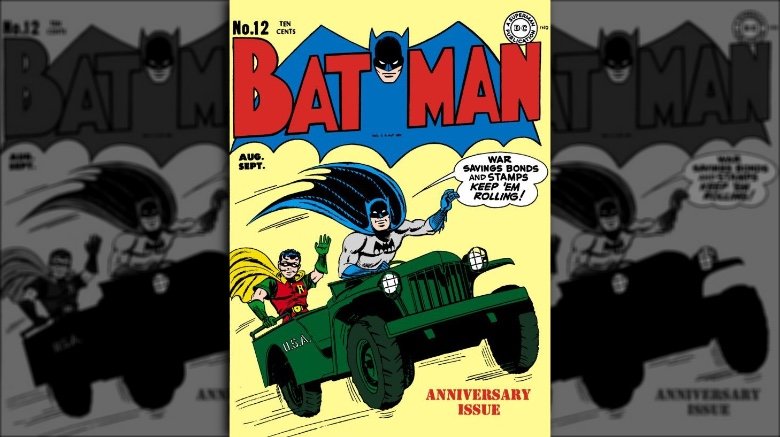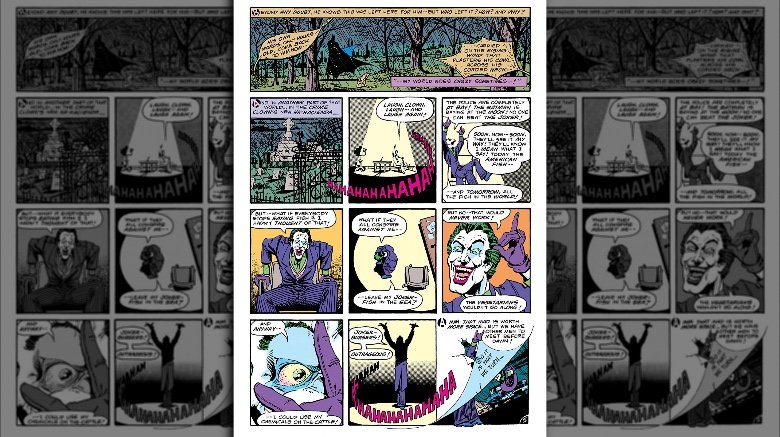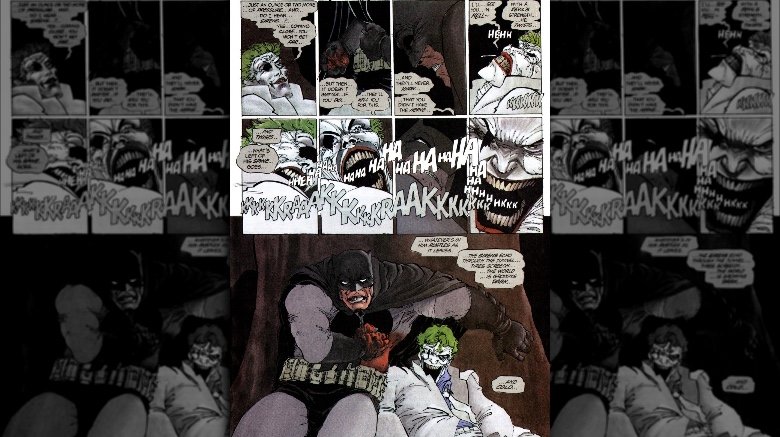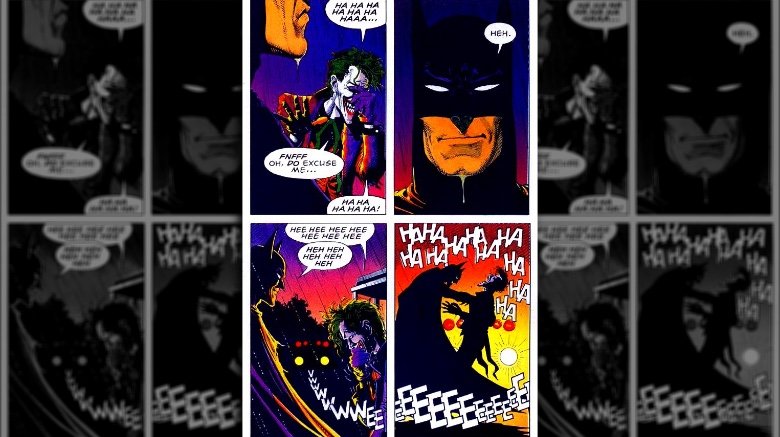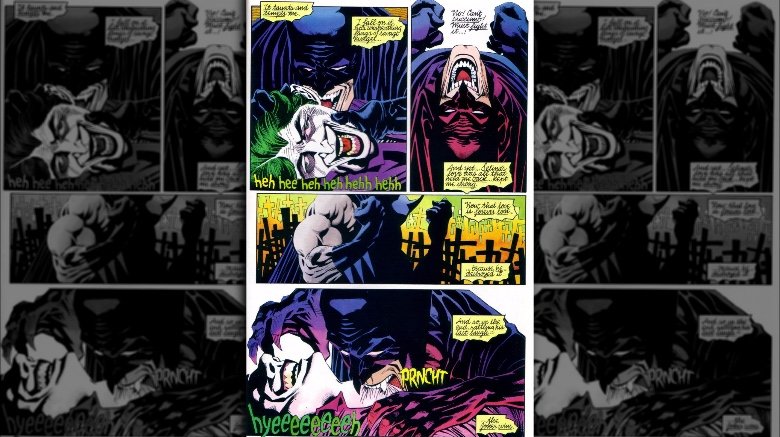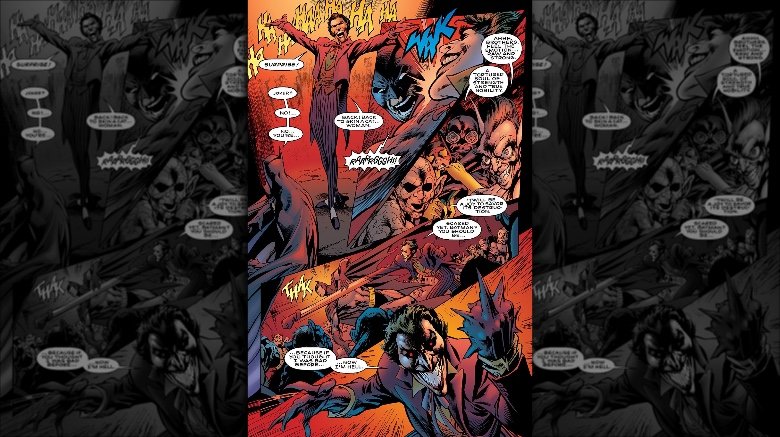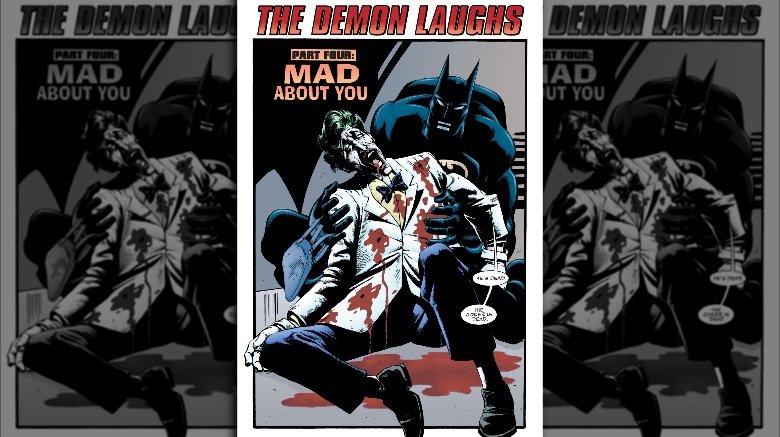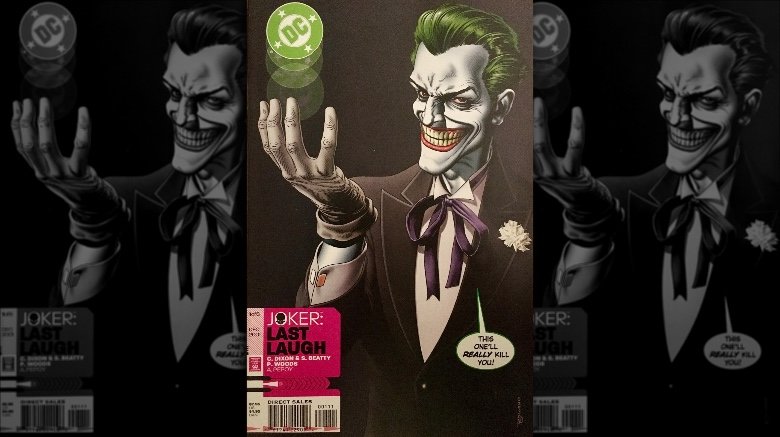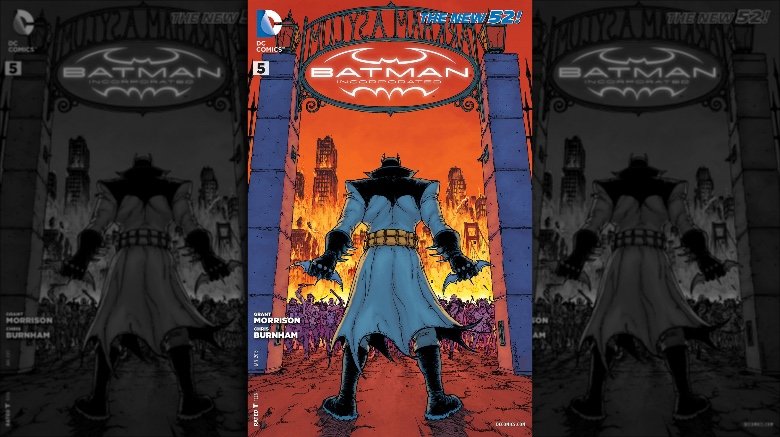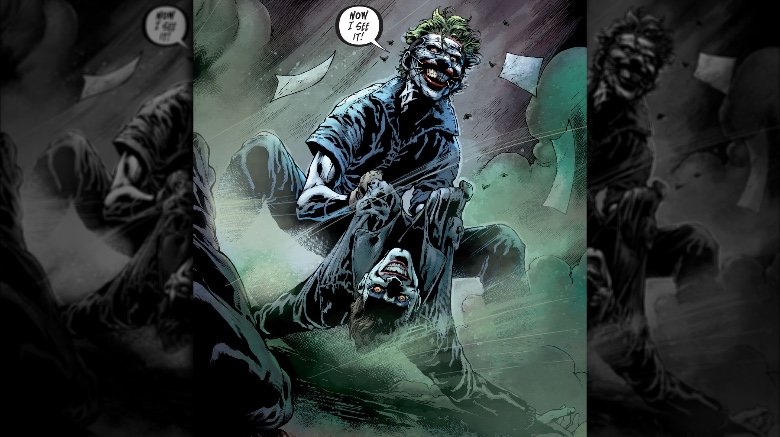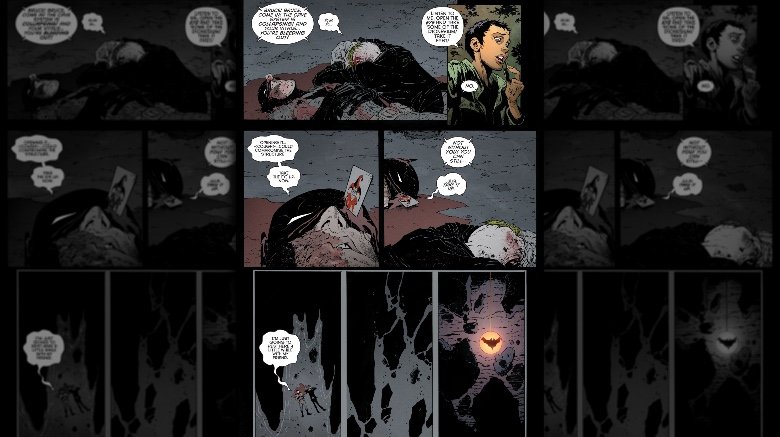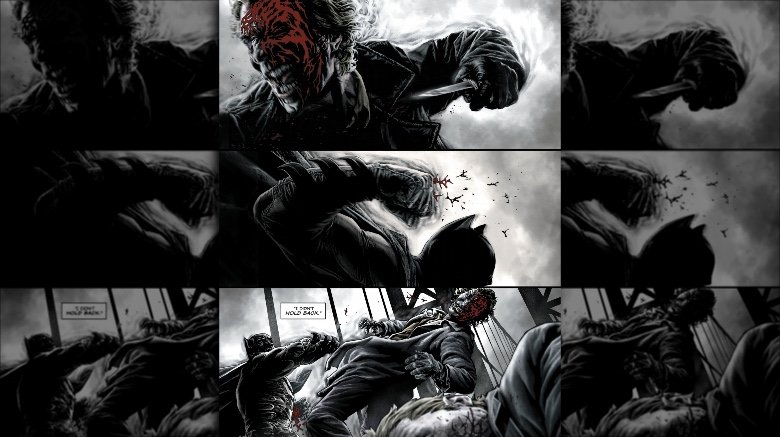Every Time The Joker Died In The Comics
In 1940, DC moved Batman from the pages of Detective Comics to his own standalone series. Batman #1 didn't just set the course for one of the most successful comic book heroes ever — it launched one of the medium's most notorious villains as well.
The Joker might not have been created to be a permanent addition to the Batman universe, but it's impossible now to imagine a Gotham without its Ace of Knaves. He's the true dark counterpart to the Dark Knight, and he's been the cause of countless deaths throughout his decades-long comics lifespan.
But what about the Joker's own deaths? While it might not seem as though the character could face the reaper, the truth is, he has — and more than a few times. The beautiful thing about comics is that most of the time, even death won't stop a popular character from returning at some point or another — and the Joker is one who just doesn't like to stay dead. Since the list of Joker deaths is a long one, we've gone ahead and sorted out his most memorable exits.
The Joker Returns (1940)
Batman #1 isn't just famous for being the first official Batman comic issue — it's responsible for introducing the Joker into the Batman canon. As it turns out, the Joker's first comics appearance could have actually been his last, if only he'd he stayed dead at the end of the "Joker Returns" storyline.
It might be easy to imagine the Joker of recent years as a more vicious, brutal character than something a couple of comic creators would have invented in 1940, but the truth is that the Joker of 1940 is just as much a psychopath as the one of the 2000s. The character starts out as a merciless killer, one who uses a toxin — the aptly named Joker Venom — that morphs his victims' faces into gruesome death smiles.
At the end of a particularly vicious killing spree, the Joker faces off against Batman and Robin on a roof. The fight continues on the ground, where the Joker ultimately stabs himself after failing to defeat the crimefighting duo. As he collapses and dies, Batman and Robin run off into the night.
Wanted: Practical Jokers (1941)
For much of the 1940s, the Joker would die at the end of a confrontation with Batman and the Boy Wonder, only to be resurrected in a subsequent issue. It's almost laughable the number of times the character actually bit the dust, then immediately came back, like some Harlequin zombie hellbent on chaos and destruction. Some deaths were pretty anticlimactic. Others were nearly comical.
In 1941's "Wanted: Practical Jokers" story, the Joker puts out an ad in the daily newspaper in search of practical jokers. When he tricks a group of pranksters into putting their fingerprints on weapons he's used in prior crimes, the Joker blackmails them into committing dangerous pranks throughout Gotham. There's a run-in with a horde of Joker imitators, a jewel heist, and a fight on the roof of a train before Batman punches the Joker and he falls to his supposed death in the river below.
The Wizard of Words (1942)
The 1942 story "The Wizard of Words" appeared in Batman #12, and it marked the last Joker "death" until the 1970s. In the story, the Joker and his henchmen begin to commit crimes based on word play. At one point, he mixes acid with red paint to "paint the town red" — a ploy he uses to weaken the structure of a bank so he can rob it. Honestly, the Joker of the 1940s seems somehow more inventive than in later years, and it's almost disappointing to know that this would be his final hurrah before moving into a couple of decades of winding up in a prison cell.
Batman and Robin do their usual detective work and are able to track the Joker to his ultimate destination, where he and the Dark Knight square off in a fight that lands them both in a river. When the Joker flees to an army camp, he steals a barrage balloon and the two ascend 3,000 feet into the air. There's of course more fighting, until finally Batman knocks the Joker into the water below, which he and Robin are convinced is the last time they'll ever see him.
The Sign of the Joker (1978)
By the early 1970s, the Joker made something of a return to his original psychopathic murder spree self. In 1978, Detective Comics #475 and #476 ran "The Laughing Fish" storyline by Steve Englehart, Marshall Rogers, and Terry Austin. In the first half of the story, the Joker attempts to trademark poisoned fish that bear a resemblance to his own face — so-called "Joker Fish" (they would also make an appearance on the '90s TV show Batman: The Animated Series). When the clerk refuses to do so, the Joker sets up an elaborate, multi-poison plan to kill him.
In the follow-up story "The Sign of the Joker," the Joker continues his quest to patent his famous fish, targeting another man and using the man's cat as a delivery system. Batman catches up with the Joker at a construction site, and after a lengthy battle in the rain, lightning strikes and sends an electrocuted Joker into the water below. His body isn't recovered, so it's assumed that he's died — but that, of course, is a lie.
Hunt the Dark Knight (1986)
In 1986, Frank Miller (Sin City, 300) took on the task of reinventing the Caped Crusader in The Dark Knight Returns, a four-part story that takes place a decade after Batman's retirement. It sees a darker, more pessimistic version of Gotham's hero — one who's reluctant to return to a life of crimefighting but must do so strictly as a last resort.
The Dark Knight Returns is a long and complicated story that involves mutant gangs, multiple villains, an epic battle between Batman and Superman, and the Russians. But in "Hunt the Dark Knight," the Joker attempts to discredit Batman on national television with the help of a psychiatrist by claiming to be one of the vigilante's victims. Batman winds up tracking down the Joker with the intent to finally kill him, and the two engage in a fight that ends with Batman breaking the Joker's neck and paralyzing him. In a sick turn of events, the Joker takes it upon himself to finish the job and kills himself by twisting his own neck.
The Killing Joke (1988)
Alan Moore's The Killing Joke is arguably one of the best Joker storylines ever written. It offers a backstory to the character that's often used in screen adaptations — an aspiring comic desperate to provide for his pregnant wife gets caught up with the local mob and agrees to help commit a burglary under the guise of Red Hood. When the robbery goes awry, the man set to become the Joker finds himself confronted by Batman and, in an effort to escape, falls into a chemical vat. He emerges as the character we've all grown to know and love, hellbent on destroying Batman's life.
Years pass, and the Joker sets his sights on Commissioner Gordon and his daughter, Barbara. When Batman finally catches up to him, he attempts to come to some sort of peace agreement, but the Joker refuses on account of it being "too late."
There's a lot of subtlety in The Killing Joke, particularly when it comes to the story's violent tendencies. Acts are hinted at without ever fully being disclosed, and it's in this way that we see Batman take the Joker's life in the final panel — hands around his neck until the laughter dies, literally.
Batman: Bloodstorm (1994)
As an Elseworlds story, 1994's Batman: Bloodstorm doesn't take place in the regular DC continuity. Rather, it's set in a Gotham that's overrun by vampires, one in which the biggest threat to a newly turned vampire Batman is Dracula himself. Bloodstorm is the second part of the vampiric trilogy — it takes place immediately after Batman faces off with Dracula, destroying him along with the bulk of his minions.
Those who survived Batman's attack fall under the Joker's command, and he uses them to take control of the entire city. Batman, along with Selina Kyle (who's a werecat of some sort in this universe), attempts to take out the Joker's newfound army, but when Selina takes a fatal blow aimed for Batman, the vampire Knight loses control and drains the Joker's blood. The act doesn't just kill the Joker, though — it sets Batman down a path toward his own demise.
The Nail (1998)
In 1998, Justice League of America: The Nail set out to answer the question of what the world would look like without Superman. Another Elseworlds storyline, The Nail begins with Jonathan and Martha Kent out for a drive when they suffer a flat tire. The accident prevents them from discovering Superman, which creates a future in which society kind of hates metahumans, and those with powers are considered outsiders.
In Gotham, the Joker has gotten hold of a pair of energy-producing gauntlets made from alien technology, which he uses to set the inmates of Arkham free inside the asylum. Batman, Robin, and Batgirl face off against the Clown Prince of Crime, but the trio are easily captured. The Joker, being the complete psychopath that he is, uses the gauntlets to tear Robin and Batgirl into pieces in front of Batman. When Catwoman comes in to set the Dark Knight free, he attacks the Joker in a rage and snaps his neck on live TV.
The Joker would return in 2004's Another Nail, in which dimensional forces allow him to escape from Hell, but he's returned to the underworld with the help of Robin's and Batgirl's spirits.
The Demon Laughs (2001)
The Demon Laughs is a three-part story arc in Batman: Legends of the Dark Knight that centers on the unexpected team-up between Ra's al Ghul and the Joker. Knowing he won't be able to take over the world alone, Ra's al Ghul and his daughter, Talia, approach the Joker with a plan: rid the entire world of its population, including Batman. The Joker is all for the idea at first, but soon comes to realize that he won't be necessary to Ra's once the deed is done, so he makes up his mind to double-cross the pair.
Ultimately, the Joker's plan falls through — both al Ghuls are immune to the deadly contagion the three planned to release into the world, and Ra's, knowing now that the Joker has betrayed him, has Talia shoot him.
He's revived, via the Lazarus Pit, but for a brief moment, Batman legitimately loses his foe. The best part about this series, though, has nothing to do with the Joker dying in Batman's arms, and everything to do with its shift in focus from the Dark Knight to a couple of his greatest enemies.
Batman: The Joker's Last Laugh (2001)
In 2001, The Joker's Last Laugh brought together a slew of DC characters, including a number of villains who become altered versions of themselves thanks to a weaponized gas put together by a terminally ill Joker. Apparently, the story was originally intended to have more lasting consequences for its characters than it did — creators Chuck Dixon and Scott Beatty told Newsarama in 2017 that they were looking to make some real change in the DC universe. "We wanted a crossover with consequence rather than a reset to the same status quo that preceded the event," Beatty said. "Somebody had to die. And consequently, there would be mourning and ire and grand drama that would drive the Bat-titles for a year afterward."
Regardless of what ultimately unfolded in their story, The Joker's Last Laugh did give readers a legitimate Joker death — and at the hands of someone other than Batman, no less. After the Joker successfully "jokerizes" a number of DC villains, the idea that Robin has died at the hands of one of them sends Nightwing over the edge, and he beats the Joker to death... at least, temporarily.
Asylum (2013)
Grant Morrison's Batman #666 is a one-shot released in 2007 that tells the story of Damian Wayne — Bruce Wayne and Talia al Ghul's son, and a much, much darker version of Batman than his father ever was. He's also sold his soul to the Devil, so he's got the benefit of supernatural healing abilities. Damian has no problem with killing, nor does he have a problem with turning Gotham into its own private prison.
He does try to do the right thing, though. And in the "Asylum" story in Batman, Incorporated #5, Batman's attempt to do good goes very, very badly. As the Joker Virus sweeps over Gotham, turning everyone within its borders into a jokerized zombie, Batman discovers a baby who shows no sign of infection. Thinking the child is the answer to a cure, he saves it, only to discover that it, in fact, is merely a carrier for the virus. As the jokerized horde closes in on him, the U.S. government drops a nuclear bomb on the city.
The Punchline (2013)
Scott Snyder, Greg Capullo, and Jonathan Glapion created one hell of a Joker for the New 52. This iteration had allowed another villain — the Dollmaker — to remove his face at the beginning of the run, and he spent the rest of his time wearing it loosely like a mask. In Death of the Family, everything between the Joker and Batman comes to a head, and it leaves Batman more alone than he's ever been.
When the Joker captures Batman's family members, he tortures each one individually, telling them secrets he's learned about their beloved patriarch. His hope is to take Batman's family away so the two of them will be left with only each other. At one point, he tells everyone in Batman's family that he's removed their faces too, which he serves to them during an elaborate dinner. After some back and forth about revealing secret identities, Batman convinces the Joker he knows his true identity, and it sends the Joker hurtling into a chasm deep within the Batcave.
The Joker: Endgame (2015)
In all the instances where the Joker has died throughout his comics history, none have been as poetic as his death in The Joker: Endgame. Picking up sometime after the events of Death of the Family, it turns out the Joker has survived his fall in the Batcave, and now he's just really ticked off at Batman for letting him down.
To get back at Batman (and the entire city of Gotham), the Joker releases a powerful venom that not only jokerizes its victims, but forces them to attack those they love. As the city falls into chaos, Batman searches the caves beneath Gotham for a cure but finds an area rigged with explosives instead. He and the Joker engage in a final battle, one in which the pair are both mortally wounded. Batman asks that the Joker stay with him as he dies, and shortly thereafter a piece of the cave breaks loose and crushes the Joker.
Batman: Damned (2019)
In 2018, DC launched its Black Label, a platform for artists to tell mature DC stories without having to worry about continuity. The first comic released through the imprint was Batman: Damned, a three-part supernatural story by Brian Azzarello and Lee Bermejo, which the pair has described as a sort-of sequel to their 2008 graphic novel Joker.
Batman: Damned starts its story with Joker's death. We know he fell off the Gotham Bridge, and we think Batman may be responsible for it — in fact, Batman himself is afraid he may have been the cause of Joker's demise... he just can't remember it. In search of answers, he seeks out Constantine, who takes him on a journey into the supernatural underbelly of the DC universe. Batman does eventually get his answer, via a few choice encounters and some time travel. We won't spoil it for you here, but you can probably guess how the Joker fares.
